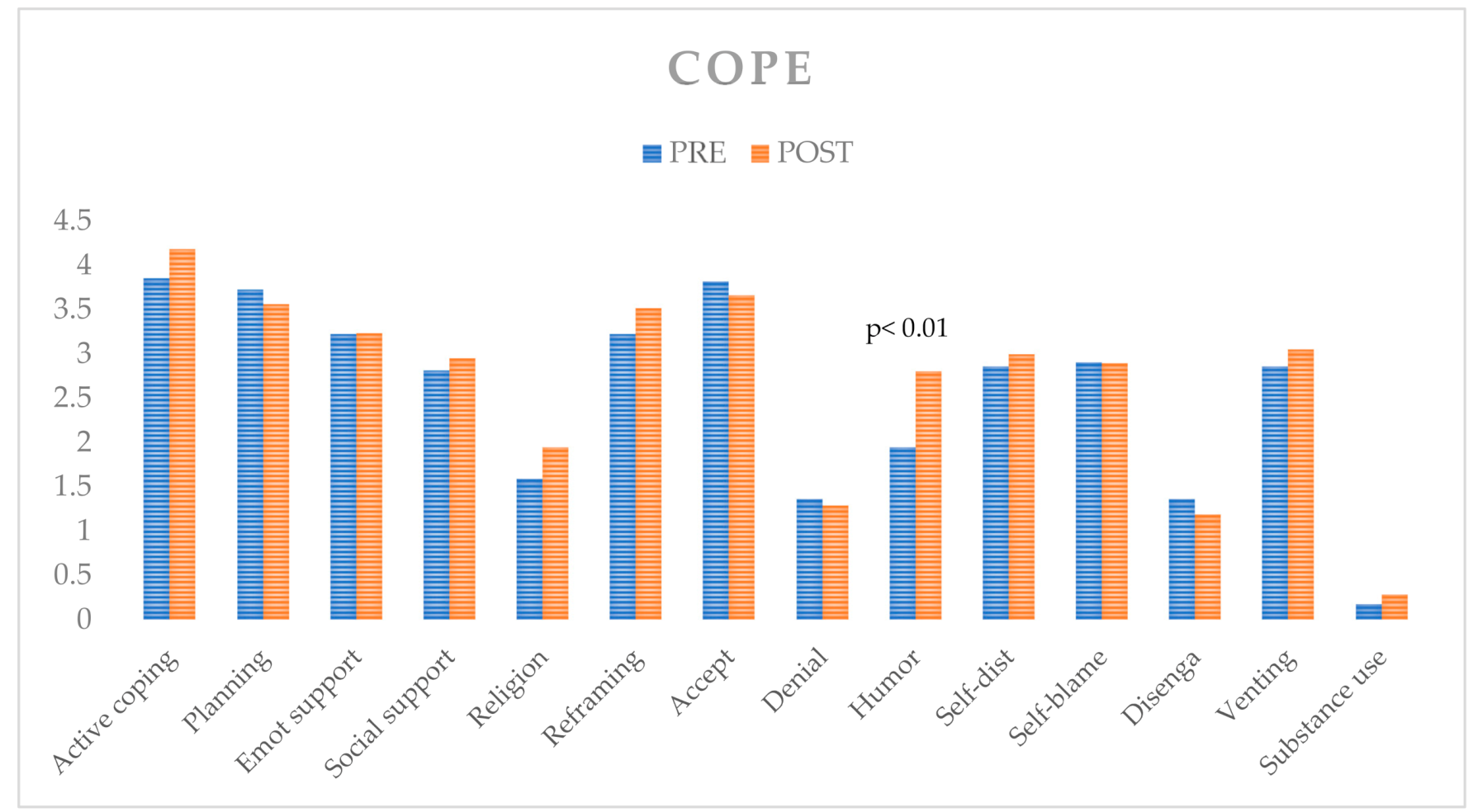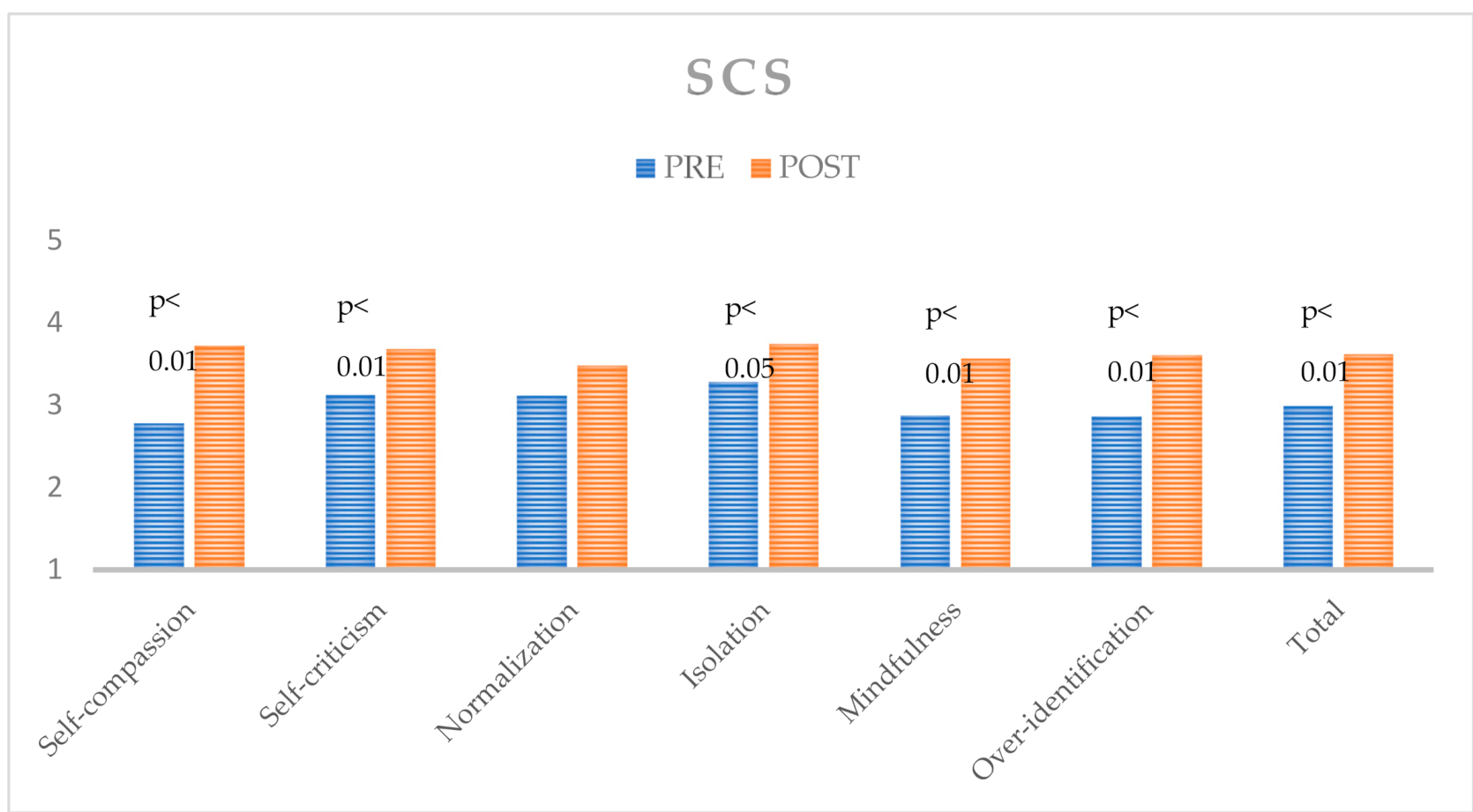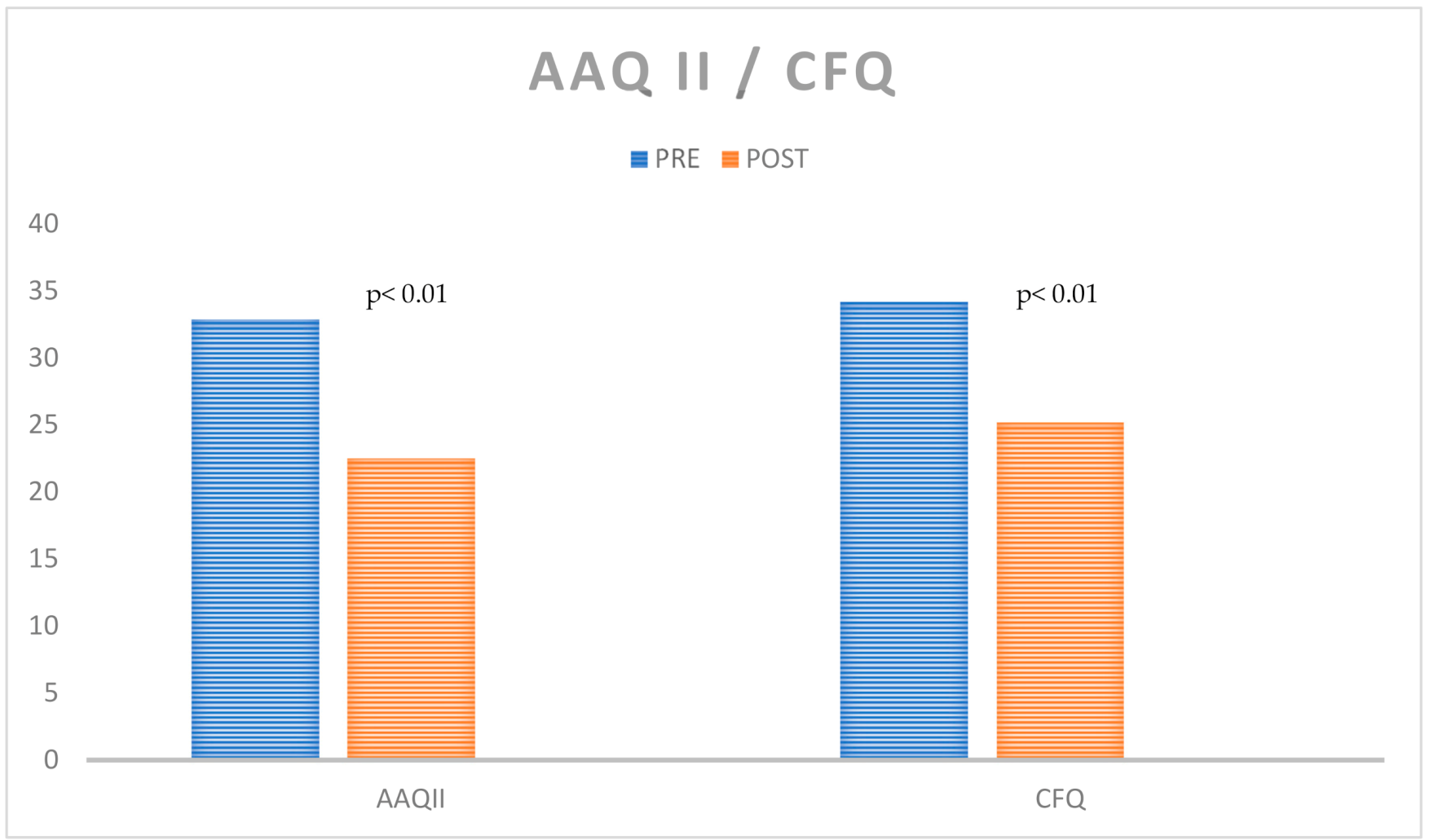Impact of a Mindfulness and Self-Care Program on the Psychological Flexibility and Well-Being of Parents with Children Diagnosed with ADHD
Abstract
1. Introduction
2. Materials and Methods
2.1. Participants
2.2. Measures
2.2.1. Psychological Flexibility (AAQ-II)
2.2.2. COPE 28 (Brief COPE)
2.2.3. Five Facets of the Mindfulness Questionnaire (FFMQ)
2.3.4. Self-Compassion Scale (SCS)
2.3.5. Cognitive Fusion Questionnaire (CFQ)
2.3. Design
2.4. Procedure
2.5. Statistical Analysis
3. Results
4. Discussion
5. Conclusions
Author Contributions
Funding
Conflicts of Interest
References
- Schneiderman, N.; Ironson, G.; Siegel, S. Stress and health: Psychological, behavioral and biological determinants. Annu. Rev. Clin. Psychol. 2005, 1, 607–628. [Google Scholar] [CrossRef]
- Black, D.S.; Slavich, G.M. Mindfulness meditation and the immune system: A systematic review of randomized controlled trials. Ann. New York Acad. Sci. 2016, 1373, 13–24. [Google Scholar] [CrossRef]
- Segerstrom, S.C.; Miller, G.E. Psychological stress and the human immune system: A meta-analytic study of 30 years of inquiry. Psychol. Bull. 2004, 130, 601–630. [Google Scholar] [CrossRef]
- Mitchell, A.J.; Chan, M.; Bhatti, H.; Halton, M.; Grassi, L.; Johansen, C.; Meader, N. Prevalence of depression, anxiety, and adjustment disorder in oncological, haematological, and palliative-care settings: A metaanalysis of 94 interview-based studies. Lancet Oncol. 2011, 12, 160–174. [Google Scholar] [CrossRef]
- Fernández, M.L.Á. Redes de apoyo social y padres de niños con trastornos del desarrollo. Diferencias estructurales y funcionales basadas en la tipología. Rev. Psicol. Educ. 2016, 11, 7–24. [Google Scholar]
- Martín-Antón, L.J.; Carbonero, M.A.; Valdivieso, J.A.; Monsalvo, E. Influence of some personal and family variables on social responsibility among primary education students. Front. Psychol. 2016, 11, 1124. [Google Scholar] [CrossRef]
- Díaz, A.; Jiménez, J.E.; Rodríguez, C.; Afonso, M.; Artiles, C. Consideraciones de los estudios de prevalencia del trastorno por déficit de atención con o sin hiperactividad (TDAH). Rev. Psicol. Educ. 2013, 8, 155–170. [Google Scholar]
- Cairncross, M.; Miller, C.J. The effectiveness of mindfulness-based therapies for ADHD: A meta-analytic review. J. Atten. Disord. 2020, 24, 627–643. [Google Scholar] [CrossRef]
- Rodríguez-Pérez, C.; García-Sánchez, J.N.; González-Castro, P.; Álvarez-García, D.; González-Pienda, J.A.; Bernardo, A.; Álvarez-Pérez, L. TDAH y el solapamiento con las Dificultades de Aprendizaje en escritura. Rev. Psicol. Educ. 2011, 6, 37–56. [Google Scholar]
- Segal, R.; Hinojosa, J. The activity setting of homework: An analysis of three cases and implications for occupational therapy. Am. J. Occup. 2006, 60, 50–59. [Google Scholar] [CrossRef][Green Version]
- Lee, P.C.; Niew, W.I.; Yang, H.J.; Chen, V.C.; Lin, K.C. A meta-analysis of behavioral parent training for children with attention deficit hyperactivity disorder. Res. Dev. Disabil. 2012, 33, 2040–2049. [Google Scholar] [CrossRef] [PubMed]
- Rodrigo, M.J.; Máiquez, M.L.; García, M.; Mendoza, R.; Rubio, A.; Martínez, A.; Martín, J.C. Relaciones padres-hijos y estilos de vida en la adolescencia. Psicothema 2004, 16, 203–210. [Google Scholar]
- Betta Olivares, R.; Morales Messerer, G.; Rodríguez Ureta, K.; Guerra Vio, C. La frecuencia de emisión de conductas de autocuidado y su relación con los niveles de estrés traumático secundario y de depresión en psicólogos clínicos. Pensam. Psicológico 2007, 3. [Google Scholar] [CrossRef]
- Hayes, S.C. Acceptance and commitment therapy, relational frame theory, and the third wave of behavioral and cognitive therapies. Behav. Ther. 2004, 35, 639–665. [Google Scholar] [CrossRef]
- Hayes, S.C.; Luoma, J.B.; Bond, F.W.; Masuda, A.; Lillis, J. Acceptance and commitment therapy: Model, processes and outcomes. Behav. Res. Ther. 2006, 44, 1–25. [Google Scholar] [CrossRef] [PubMed]
- Brassell, A.; Rosenberg, E.; Parent, J.; Rough, J.N.; Fondacaro, K.; Seehuus, M. Parent´s psychological flexibility: Associations with parenting and child psychosocial well-being. J. Contextual Behav. Sci. 2016, 5, 111–120. [Google Scholar] [CrossRef]
- Salgado, C.F. Comparación de dos protocolos de intervención basados en la Terapia de Aceptación y Compromiso y Entrenamiento en Mindfulness en personas con Trastorno Mental Crónico. Análisis Modif. Conducta 2016, 42, 75–98. [Google Scholar] [CrossRef][Green Version]
- Greco, L.A.; Hayes, S.C. Acceptance and Mindfulness Treatments for Children and Adolescents: A Practitioner’s Guide; New Harbinger Publications: Oakland, CA, USA, 2008. [Google Scholar]
- Luciano, C. Evolución de ACT. Análisis Modif. Conducta 2016, 41, 1–28. [Google Scholar] [CrossRef]
- Hervás, G.; Cebolla, A.; Soler, J. Intervenciones psicológicas basadas en mindfulness y sus beneficios: Estado actual de la cuestión. Clínica Salud 2016, 27, 115–124. [Google Scholar] [CrossRef]
- Vago, D.R.; Silbersweig, D.A. Self-awareness, self-regulation, and self-transcendence (S-ART): A framework for understanding the neurobiological mechanisms of mindfulness. Front. Hum. Neurosci. 2012, 6, 296. [Google Scholar] [CrossRef]
- Van der Oord, S.; Bögels, S.M.; Peijnenburg, D. The effectiveness of mindfulness training for children with ADHD and mindful parenting for their parents. J. Child Fam. Stud. 2012, 21, 139–147. [Google Scholar] [CrossRef] [PubMed]
- Harnett, P.H.; Dawe, S. The Contribution of Mindfulness-based therapies for children and families and proposed conceptual integration. Child Adolesc. Ment. Health 2012, 17, 195–208. [Google Scholar] [CrossRef] [PubMed]
- Broderick, P.C.; Metz, S. Learning to Breathe: A pilot trial of a mindfulness curriculum for adolescents. Adv. Sch. Ment. Health Promot. 2009, 2, 35–46. [Google Scholar] [CrossRef]
- López-González, L.; Amutio, A.; Oriol, X.; Bisquerra, R. Hábitos relacionados con la relajación y la atención plena (mindfulness) de estudiantes de secundaria: Influencia en el clima de aula y el rendimiento académico. Rev. Psicodidáctica 2016, 21, 121–138. [Google Scholar] [CrossRef]
- Bond, F.W.; Hayes, S.C.; Baer, R.A.; Carpenter, K.M.; Guenole, N.; Orcutt, H.K.; Waltz, T.; Zettle, R.D. Preliminary psychometric properties of the Acceptance and Action Questionnaire—II: A revised measure of psychological flexibility and experiential avoidance. Behav. Ther. 2011, 42, 676–688. [Google Scholar] [CrossRef] [PubMed]
- Ruiz, F.J.; Langer Herrera, A.I.; Luciano, C.; Cangas, A.J.; Beltran, I. Measuring experiential avoidance and psychological inflexibility: The Spanish version of the Acceptance and Action Questionnaire—II. Psicothema 2013, 25, 123–129. [Google Scholar] [CrossRef]
- Carver, C.S. You want to measure coping but your protocol’s too long: Consider the Brief COPE. Int. J. Behav. Med. 1997, 4, 92–100. [Google Scholar] [CrossRef]
- Morán, C.; Landero, R.; González, M.C. COPE 28: Un análisis psicométrico de la versión en español del Brief COPE. Univ. Psychol. 2010, 9, 543–552. [Google Scholar] [CrossRef]
- Baer, R.A.; Smith, G.T.; Hopkins, J.; Krietemeyer, J.; Toney, L. Using self-report assessment methods to explore facets of mindfulness. Assessment 2006, 13, 27–45. [Google Scholar] [CrossRef]
- Cebolla, A.; Soler, J.; Guillen, V.; Botella, C. Psychometric properties of the Spanish validation of the Five Facets of Mindfulness Questionnaire (FFMQ). Eur. J. Psychiatry 2012, 26, 118–126. [Google Scholar] [CrossRef]
- Neff, K.D. Development and validation of a scale to measure self-compassion. Self Identity 2003, 2, 223–250. [Google Scholar] [CrossRef]
- Gillanders, D.T.; Bolderston, H.; Bond, F.W.; Dempster, M.; Flaxman, P.E.; Campbell, L.; Remington, B. The development and initial validation of the Cognitive Fusion Questionnaire. Behav. Ther. 2014, 45, 83–101. [Google Scholar] [CrossRef] [PubMed]
- Romero-Moreno, R.; Márquez-González, M.; Losada, A.; Gillanders, D.T.; Fernández- Fernández, V. Cognitive fusion in dementia caregiving: Psychometric properties of the Spanish version of the Cognitive Fusion Questionnaire. Behav. Psychol. 2014, 22, 117–132. [Google Scholar]
- Kabat-Zinn, J. Vivir con Plenitud las Crisis: Cómo Utilizar la Sabiduría del Cuerpo y de la Mente para Enfrentarnos al Estrés, el Dolor y la Enfermedad; Editorial Kairos: Barcelona, Spain, 2016. [Google Scholar]
- Kabat-Zinn, J. La práctica de la atención plena. Available online: https://www.casadellibro.com/libro-la-practica-de-la-atencion-plena/9788472456464/1160091 (accessed on 10 September 2020).
- Kabat-Zinn, J. Mindfulness en la Vida Cotidiana. Donde Quiera que Vayas Ahí Estás; Paidós: Barcelona, Spain, 2009. [Google Scholar]
- Segal, Z.V.; Williams, J.M.; Teasdale, J.D. Terapia Cognitiva de la Depresión Basada en la Consciencia Plena. Un Nuevo Abordaje Para la Prevención de las Recaídas; Desclée de Brouwer: Bilbao, Spain, 2006. [Google Scholar]
- López-López, J.C.; Luciano, C. An experimental analysis of defusion interactions based on deictic and hierarchical framings and their impact on cognitive performance. Psychol. Rec. 2017, 67, 485–497. [Google Scholar] [CrossRef]
- Hayes, S.C.; Strosahl, K.D.; Wilson, K.G. Acceptance and Commitment Therapy: The Process and Practice of Mindful Change; Guilford Press: New York, NY, USA, 2011. [Google Scholar]




| SESSIONS | CONTENT |
|---|---|
| SESSION 1 | Goal: Introduction to the program. Looking at the difference between what the person experiences through feelings and what they experience mentally. The metaphor of the boxing match is used to address the problems of the fight between distress and the benefits of the observer’s position. Self-care is introduced; the definition and the key attitudes of mindfulness. First initial practice. Pre-test evaluation. |
| SESSION 2 | Goal: To commence practice with mindfulness, starting with what we experience physically. Mindfulness of posture. Introduction of the concept of controlling unpleasant personal events at complicated moments, as a problem more than as a solution. Practice: the practice of body exploration was introduced. |
| SESSION 3 | Goal: To introduce breathing as a place to pleasantly return to when one realizes the coming and going of the mind. Breathing as an anchor. This is a practice which enhances the capacity to observe and accept what one is doing in the here and now, whatever it might be. Practice: Ten-minute practice in attention to breathing. Self-care 1: Stopping physical inactivity. Short focus on breathing and smells. |
| SESSION 4 | Goal: To maintain and generalize the practice of breathing and to introduce mindfulness in movement. Practice: Proposal for a practical exercise which the person can do anywhere: “a three-minute space for breathing”. Self-care 2: Increasing physical activity. |
| SESSION 5 | Goal: Starting to mobilize attention to various points rather than maintaining it on one point as an anchor to return to when the person becomes distracted. These are the first steps towards monitoring everything which becomes present (thoughts, feelings, emotions, sensations, etc.). Practice: Attention to breathing and body. Three-minute space for breathing, and planning moments of practice. Self-care 3: Awareness when eating. Short focus on walking. |
| SESSION 6 | Goal: Continuing the practice in consciously mobilizing attention to different aspects. Practice: Attention to sounds. Full awareness of posture, body, breathing, sounds and thoughts. Self-care 4: Cultivate your social network and act with compassion. Full attention walking. |
| SESSION 7 | Goal: To introduce deictic keys. Separating the person who thinks and feels from their own thoughts and feelings. Practice: Attention to touch. Distinguishing who I am + observer exercise. Self-care 5: Find a rhythm of sleep that works. Full attention walking. |
| SESSION 8 | Goal: To introduce the keys of hierarchy and/or inclusion, as a means of identifying that what is perceived as personal events are within one, such that one is greater than all of it. Practice: Three-minute space for breathing: Who is greater? Distancing exercise. Self-care 6: Get involved in meaningful activities. Visual contact exercise. |
| SESSION 9 | Goal: To introduce relational keys into psychological flexibility (deictic and hierarchical keys) with stimuli and in real neutral situations. Self-compassion is also introduced as a way to relate amicably to oneself. Practice: Attention to breathing. Work in flexibility with neutral situations. Self-care 7: Be nice to yourself. Self-compassion. |
| SESSION 10 | Goal: To practice full attention enriched with deictic and hierarchical keys with personal events and unpleasant situations. To promote the development of self-compassion at difficult moments. Practice: Full attention to breathing, body, sound, and thoughts. Work with flexibility with unpleasant situations. Self-care 8: Treat yourself well and eliminate exposure to toxins. Continuation of self-compassion. |
| SESSION 11 | Goal: To apply everything that has been learnt to complicated personal situations and events that appear in the session itself. Practice: Letting be. Deliberately bringing what is complicated to mind. Practicing self-compassion. |
| SESSION 12 | Goal: To compare initial and final practice. To evaluate the goals which the person brought up at the start of the protocol. To evaluate the program, the practices they liked most, and to forecast how continuing to practice and plan practical commitments in the future will prove useful. Practice: Body exploration. Review of the program. Looking to the future. Post-test evaluation. |
| Pre-Test | Post-Test | Z | p | r | |
|---|---|---|---|---|---|
| Dimensions | M(SD) | M(SD) | |||
| Active coping | 3.86 (1.04) | 4.19 (1.03) | −1.107 | 0.268 | — |
| Planning | 3.73 (1.03) | 3.57 (1.08) | −0.480 | 0.631 | — |
| Emotional support | 3.23 (1.27) | 3.24 (1.64) | −0.540 | 0.799 | — |
| Social support | 2.82 (1.26) | 2.95 (1.50) | −0.080 | 0.936 | — |
| Religion | 1.59 (1.50) | 1.95 (1.75) | −0.929 | 0.353 | — |
| Reframing | 3.23 (1.19) | 3.52 (1.33) | −0.842 | 0.400 | — |
| Acceptance | 3.82 (1,40) | 3.67 (1.46) | −0.726 | 0.468 | — |
| Denial | 1.36 (1.46) | 1.29 (1.62) | −0.436 | 0.663 | — |
| Humor | 1.95 (1.29) | 2.81 (1.44) | −2.431 | 0.015 | 0.51 |
| Self-distraction | 2.86 (1.52) | 3.00 (1.61) | −0.470 | 0.639 | — |
| Self-blame | 2.91 (1.27) | 2.90 (1.38) | −0.179 | 0.858 | — |
| Disengagement | 1.36 (1.33) | 1.19 (1.08) | −0.128 | 0.898 | — |
| Venting | 2.86 (1.58) | 3.05 (1.40) | −0.071 | 0.943 | — |
| Substance use | 0.18 (0.85) | 0.29 (0.78) | −0.272 | 0.785 | — |
| Pre-Test | Post-Test | Z | p | r | |
|---|---|---|---|---|---|
| Dimensions | M(SD) | M(SD) | |||
| Self-compassion | 2.78 (0.83) | 3.73 (0.79) | −3.817 | <0.001 | 0.81 |
| Self-criticism | 3.13 (0.73) | 3.68 (0.63) | −2.943 | 0.003 | 0.62 |
| Normalization | 3.12 (0.83) | 3.48 (0.98) | −1.657 | 0.098 | — |
| Isolation | 3.29 (1.00) | 3.75 (0.75) | −2.241 | 0.025 | 0.48 |
| Mindfulness | 2.88 (0.85) | 3.57 (0.94) | −2.654 | 0.008 | 0.56 |
| Over-identification | 2.87 (1.04) | 3.61 (0.76) | −3.572 | <0.001 | 0.76 |
| Total | 2.99 (0.66) | 3.62 (0.55) | −3.680 | <0.001 | 0.78 |
| Pre-Test | Post-Test | Z | p | r | |
|---|---|---|---|---|---|
| Dimensions | M(SD) | M(SD) | |||
| Observation | 23.09 (6.69) | 30.14 (4.92) | −3.530 | <0.001 | 0.75 |
| Description | 26.45 (5.75) | 27.17 (5.40) | −1.782 | 0.075 | — |
| Acting with awareness | 21.50 (5.34) | 25.38 (3.38) | −2.808 | 0.005 | 0.60 |
| Not judging | 24.36 (7.80) | 27.24 (6.73) | −1.396 | 0.163 | — |
| Not reacting | 18.18 (4.62) | 22.71 (4.24) | −3.270 | 0.001 | 0.70 |
| Total FFMQ | 113.59 (22.88) | 134.61 (18.70) | −3.581 | <0.001 | 0.76 |
| Pre-Test | Post-Test | Z | p | r | |
|---|---|---|---|---|---|
| Dimensions | M(SD) | M(SD) | |||
| AAQ II | 32.91 (8.14) | 22.52 (6.58) | −3.925 | <0.001 | 0.84 |
| CFQ | 34.18 (7.00) | 25.19 (6.68) | −3.861 | <0.001 | 0.82 |
© 2020 by the authors. Licensee MDPI, Basel, Switzerland. This article is an open access article distributed under the terms and conditions of the Creative Commons Attribution (CC BY) license (http://creativecommons.org/licenses/by/4.0/).
Share and Cite
Salgado-Pascual, C.F.; Martín-Antón, L.J.; Carbonero, M.Á. Impact of a Mindfulness and Self-Care Program on the Psychological Flexibility and Well-Being of Parents with Children Diagnosed with ADHD. Sustainability 2020, 12, 7487. https://doi.org/10.3390/su12187487
Salgado-Pascual CF, Martín-Antón LJ, Carbonero MÁ. Impact of a Mindfulness and Self-Care Program on the Psychological Flexibility and Well-Being of Parents with Children Diagnosed with ADHD. Sustainability. 2020; 12(18):7487. https://doi.org/10.3390/su12187487
Chicago/Turabian StyleSalgado-Pascual, Carlos F., Luis J. Martín-Antón, and Miguel Á. Carbonero. 2020. "Impact of a Mindfulness and Self-Care Program on the Psychological Flexibility and Well-Being of Parents with Children Diagnosed with ADHD" Sustainability 12, no. 18: 7487. https://doi.org/10.3390/su12187487
APA StyleSalgado-Pascual, C. F., Martín-Antón, L. J., & Carbonero, M. Á. (2020). Impact of a Mindfulness and Self-Care Program on the Psychological Flexibility and Well-Being of Parents with Children Diagnosed with ADHD. Sustainability, 12(18), 7487. https://doi.org/10.3390/su12187487







